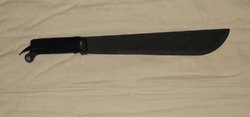Machete
|
|
The machete (International Phonetic Alphabet: ) is a cleaver-like tool that looks like a very large bread knife. The blade is typically 50–60 cm (18–24 in) long. An English equivalent term is matchet.
Since the 1950s, most modern factory made machetes are of very simple construction, consisting of a blade and full length tang punched from a single piece of flat steel plate of uniform thickness (and thus lack a primary grind), and a simple grip of two plates of wood or plastic bolted or rivetted together around the tang. Finally, one side is ground down to an edge - although some are made so cheaply that the purchaser is expected to finish the sharpening. These machetes are usually provided with a simple cord loop as a sort of lanyard, and a canvas scabbard - although in some regions where machetes are commonly used tools, the users may make decorative leather scabbards for them.
The machete is normally used to cut through thick vegetation such as sugar cane or jungle undergrowth (the lack of a primary grind makes the machete much less effective on woody vegetation), but it can also be used as an offensive weapon. Machetes were the primary weapon used by the Interahamwe militias in the Rwandan Genocide, as well as the signature tool/weapon of the Haitian Tonton Macoute. The machete was also one of the most common weapons during the Cuban Independence War. Freed slaves by Carlos Manuel de CÚspedes agreed to fight against Spain, where their only weapons were the very tool they used to cut the sugar cane in the La De Majagua plantation.
Some tropical countries have a name for the blow of a machete; the Spanish machetazo is sometimes used in English. In Trinidad to hit someone with the broad side of the blade is termed planass.
The modern machete is very similar to some forms of the medieval falchion (a type of sword), differing mainly in the lack of a guard and a simpler hilt.
The panga (a Swahili word) is a variant used in East Africa, with a broader blade and a squared off tip. In the Philippines, the bolo is a very similar tool, but with the blade swelling just before the tip to make the knife even more tip-heavy for chopping. This was also used during the Philippine Revolution against the Spanish, and later a signature weapon of guerillas in the Philippine American War.
Other similar tools include the parang and the golok (from Malaysia and Indonesia), however these tend to have shorter, thicker blades with a primary grind, and are more effective on woody vegetation.de:Machete es:Machete sv:Machete

